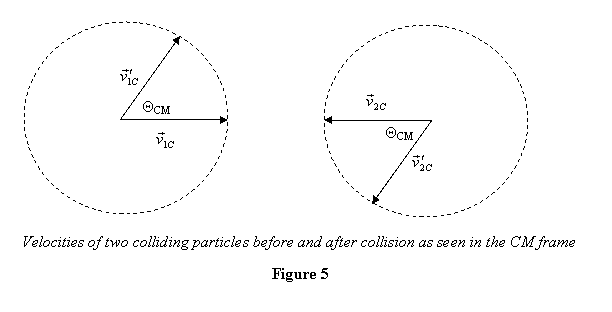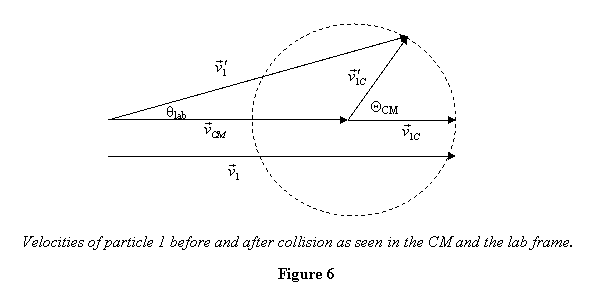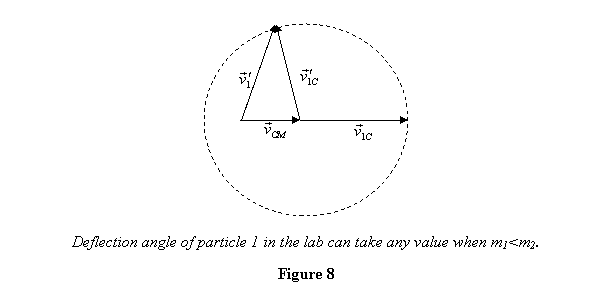Now
we consider a two-particle elastic collision in a plane
and analyze it. This could be the collision of a striker
and a coin on a carom board, for example. It is a two-dimensional
case. We are going to analyze the motion graphically.
First we look at the velocities in the CM frame. If we
take the initial direction of particle 1 towards +x ,
the velocities of the two particles before and after
collision can be shown as done in figure 5. Keep in mind
that in an elastic collision, the magnitude of the velocities
of each particle remains unchanged in the CM frame. However
the direction of the velocity for each particle changes
by an angle ΘCM. as shown in figure
5.

The
picture above shows the angle of scattering
in the CM frame. However experiments are done on ground - and
not in the CM frame. So we should be answering
the question: by what angle θlab does
particle 1 scatter in the laboratory frame? Since velocities  and
and  in
the lab frame are given as
in
the lab frame are given as  ,
the relationship between these velocities
can be shown as done in figure 6.
,
the relationship between these velocities
can be shown as done in figure 6.

From figure 6, it is now very easy to see that

Similar relationships can also be derived for particle
2. Now if particle 2 was at rest when hit by particle
1, then

This gives

Let us now look at two cases: m1 > m2 and m1 < m2 .
In the case of m1 > m2 , θlab cannot
be greater than a particular angle θmax.
This can be either calculated by using the expression
above or alternatively, graphically as we do. For m1 > m2 we
also have vCM >v1C .
Thus a picture showing the velocities in the laboratory
and the CM frame looks like that in figure 7.

It is clear from figure 7 that the deflection angle of
particle 1, when hitting another particle of smaller
mass, increases as ΘCM increases
from zero. It is maximum when the velocities  and
and  are
perpendicular. If
are
perpendicular. If  is
rotates beyond this angle, deflection starts becoming
smaller. Thus θmax is given by the formula
is
rotates beyond this angle, deflection starts becoming
smaller. Thus θmax is given by the formula

It is clear from the expression above that when a particle
hits a lighter particle at rest, it is deflected by a
small angle. This is reasonable as a light particle can
hardy deflect a heavier particle. Thus the heavier particle
keeps on moving forward even after the collision. On
the other hand, there is no restriction on the scattering
angle when a light particle hits a heavier particle at
rest i.e. m1 < m2 .
In this case vCM < v1C and
therefore the graphical representation of different velocities
is as shown in figure 8.

It is clear from the figure that as ΘCM increases,
so does θlab. In this situation,
however, there is no restriction on the value that θlab can
take as ΘCM sweeps angles from 0 to 2π .
So far we have focused on elastic collisions only and
could learn a great deal about them from conservation
laws for momentum and energy. Such general conclusions
are difficult to draw for inelastic collisions. As discussed
in the beginning of this lecture, for inelastic collisions,
we can definitely say that the maximum possible loss
of energy is equal to the kinetic energy of particles
in their CM frame. This would occur when the colliding
particles get stuck together so that their kinetic energy
after collision is zero in the CM frame. This concludes
our lecture on collisions as analyzed using conservation
laws.